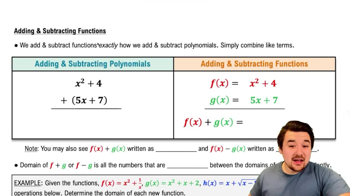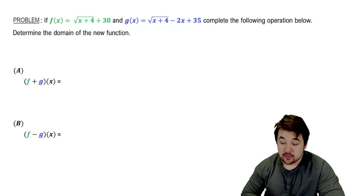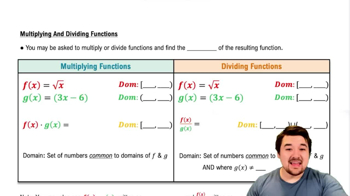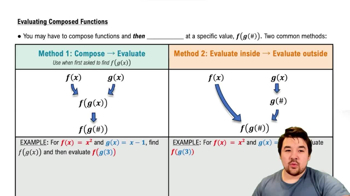Table of contents
- 0. Functions7h 52m
- Introduction to Functions16m
- Piecewise Functions10m
- Properties of Functions9m
- Common Functions1h 8m
- Transformations5m
- Combining Functions27m
- Exponent rules32m
- Exponential Functions28m
- Logarithmic Functions24m
- Properties of Logarithms34m
- Exponential & Logarithmic Equations35m
- Introduction to Trigonometric Functions38m
- Graphs of Trigonometric Functions44m
- Trigonometric Identities47m
- Inverse Trigonometric Functions48m
- 1. Limits and Continuity2h 2m
- 2. Intro to Derivatives1h 33m
- 3. Techniques of Differentiation3h 18m
- 4. Applications of Derivatives2h 38m
- 5. Graphical Applications of Derivatives6h 2m
- 6. Derivatives of Inverse, Exponential, & Logarithmic Functions2h 37m
- 7. Antiderivatives & Indefinite Integrals1h 26m
0. Functions
Combining Functions
Problem 15c
Textbook Question
Use the graphs of ƒ and g in the figure to determine the following function values. y = f(x) ; y=g(x) <IMAGE>
c. ƒ(g (4))
 Verified step by step guidance
Verified step by step guidance1
Step 1: Identify the value of g(4) using the graph of the function g(x). Locate x = 4 on the x-axis and find the corresponding y-value on the graph of g(x). This y-value is g(4).
Step 2: Once you have determined g(4), use this value as the input for the function f(x). This means you will evaluate f at the point g(4), or f(g(4)).
Step 3: Locate the value of g(4) on the x-axis of the graph of f(x). Find the corresponding y-value on the graph of f(x) for this x-value.
Step 4: The y-value you find in Step 3 is the value of f(g(4)).
Step 5: Summarize the process: You first found g(4) from the graph of g(x), then used this result as the input for f(x) to find f(g(4)) from the graph of f(x).
Recommended similar problem, with video answer:
 Verified Solution
Verified SolutionThis video solution was recommended by our tutors as helpful for the problem above
Video duration:
1mPlay a video:
Was this helpful?

 5:56m
5:56mWatch next
Master Adding & Subtracting Functions with a bite sized video explanation from Nick
Start learning




